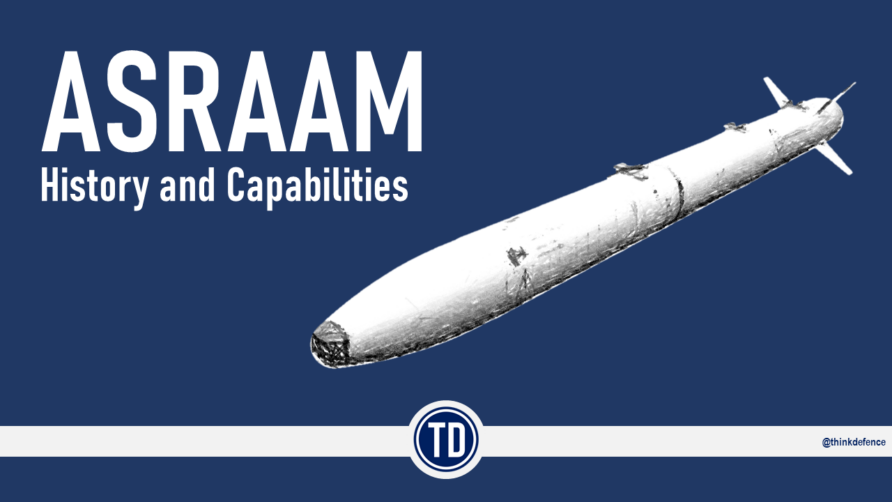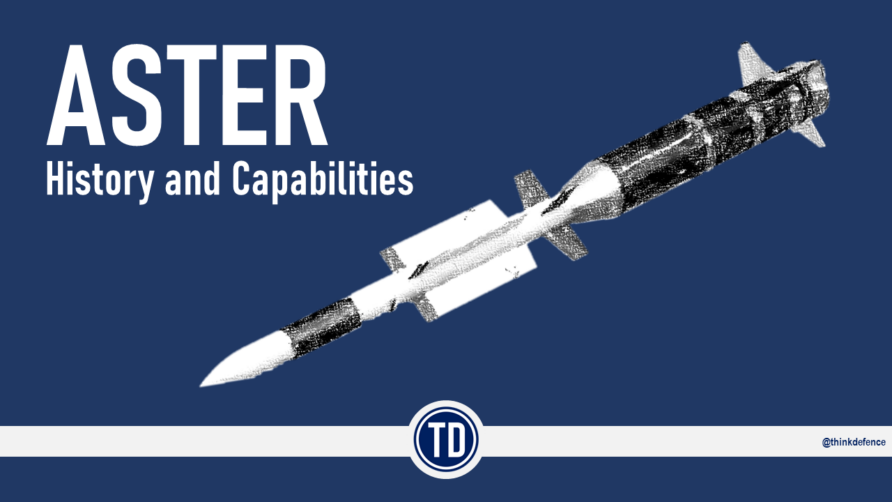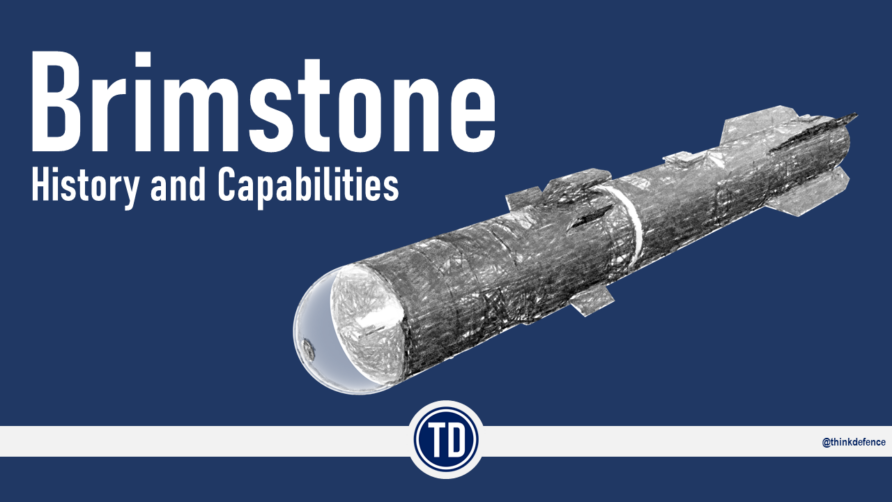The RGM-84 Harpoon is a ship-launched, all-weather, over-the-horizon, anti-ship missile that is carried by Royal Navy Type 23 and Type 45 vessels.
It is due to be replaced with the Interim Surface to-Surface Guided Weapon System (I-SSGW) and Future Cruise and Anti-Ship Weapon (FCASW) in due course
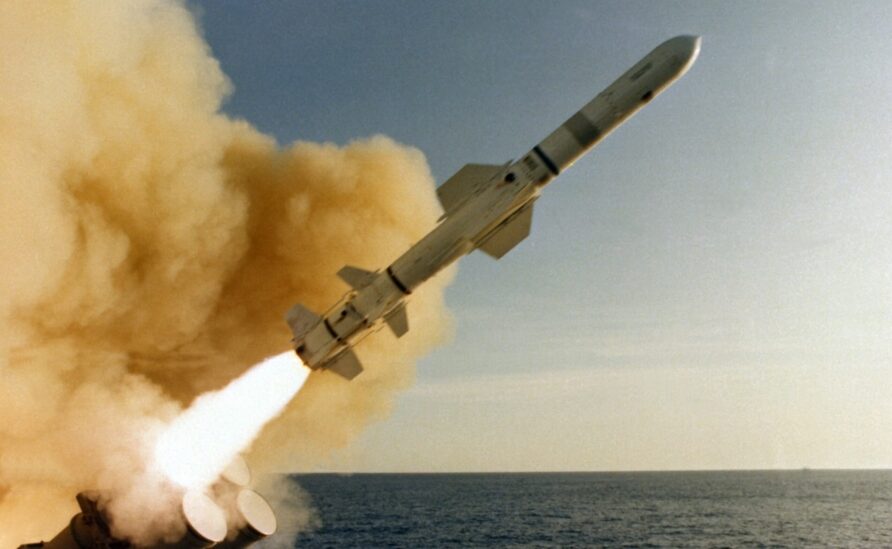
The Harpoon surface-to-surface missile was described by the Royal Navy as;
Harpoon is the long range lance of the Type 23 Frigate, capable of destroying enemy ships far beyond the horizon. Fitted to all Type 23 Frigates the Harpoon is a sophisticated anti-ship missile capable of striking targets more than 80 miles away. Harpoon uses a combination of inertial guidance and active radar homing to attack it’s prey. Cruising at Mach 0.9 and carrying a large high explosive warhead it is powered by a lightweight turbojet, but is accelerated at launch by a booster rocket.
It is currently fitted to the Type 23 Frigate and Type 45 Destroyer.
Harpoon History
Development of the Harpoon missile for the US Navy goes back to the mid-sixties as a counter to surfaced submarines, but for the Royal Navy, it first came into service as a submarine-launched weapon in the mid-seventies.
The US Navy began initial concept studies for an anti-ship missile system in 1965. In July 1971, McDonnell Douglas won a development contract and, in May 1973, the US Navy selected Harpoon. The initial requirement called for a surface, air and sub-surface launched variant of the same missile, and all three entered service in 1977.
The Royal Navy had a requirement for a submarine-launched anti-ship missile for the Under Surface Guided Weapon (UGSW) requirement.
Choices were a new development from Hawker Siddeley, designated CR137, the McDonnell Douglas Astronautics Harpoon and an Anglo-French development called Sub Martel. Sub Martel was a modification of the already-in-service Matra Martel air-to-ground missile but, compared to the already-in-service Harpoon, would require significant development funding.
Although Exocet was in service with both the UK and France, a submarine-launched development project was not considered for UGSW.
In September 1975, the MoD selected the Harpoon missile, the French went on to develop SM39 Exocet, the submarine-launched variant.
HL Deb 23 September 1975 vol 364 cc169-80169 3.0 p.m.
Lord WINTERBOTTOM My Lords, with the permission of the House, I will make a Statement on guided weapons for the Services.
The Government have now decided the next steps to be taken on the procurement of major guided weapons systems for the British Forces. Full development, by the British Aircraft Corporation, of the helicopter anti-ship missile Sea Skua is to proceed. Negotiations will be opened with France and Germany for the procurement, if the terms are right, of their medium-range anti-tank missile Milan, mainly by manufacture under licence in Britain; and with the United States for the procurement, if the terms are right, of McDonnell Douglas’s submarine-launched anti-ship missile Sub-Harpoon. The British Aircraft Corporation’s helicopter-borne anti-tank missile Hawk swing and Hawker Siddeley Dynamics’ submarine-launched anti-ship missile Sub-Martel are to be cancelled.The winding-up of the work on Sub-Martel at Hawker Siddeley Dynamics will, however, inevitably give rise to problems. Other projects which the company have in hand are unlikely to absorb all the design staff who will become available. Some loss of jobs is, therefore, likely to be unavoidable. The Ministry of Defence, however, recognises the extent to which its ability to meet its future needs is dependent on the strength of Hawker Siddeley Dynamics’ design capability.
However, it was recognised from the beginning that the costs of developing Sub-Martel would be very high and that if McDonnell Douglas’s development of their underwater-to-surface guided weapon Harpoon was successful (as it has been) that system was likely to be the more attractive proposition. This has been a particularly difficult issue to decide but the Government have now reached the conclusion that the right course is to terminate the development of Sub-Martel and open negotiations for Sub-Harpoon. The final decision will, of course, be determined by the terms that can be secured. We are making arrangements with the United States Government and McDonnell Douglas for a substantial level of offset to help with the dollar expenditure on Sub-Harpoon and to provide work in the United Kingdom.
A $6m pre-development contract was awarded to McDonnell Douglas to investigate modifications to enable use by Royal Navy submarines. Part of the deal was that British companies would design and develop the torpedo tube launch capsule
Whilst this was ongoing, Norway, the UK, USA, Germany, and the Netherlands had embarked upon the Anti-Ship Supersonic Missile study that would eventually go nowhere.
For the next year or so, there was a great deal of negotiation on UK subcontract components and other industrial issues.
By 1981, the Royal Navy had commenced firing trials of UGM-84B Sub Harpoon from Trafalgar and Swiftsure attack submarines.
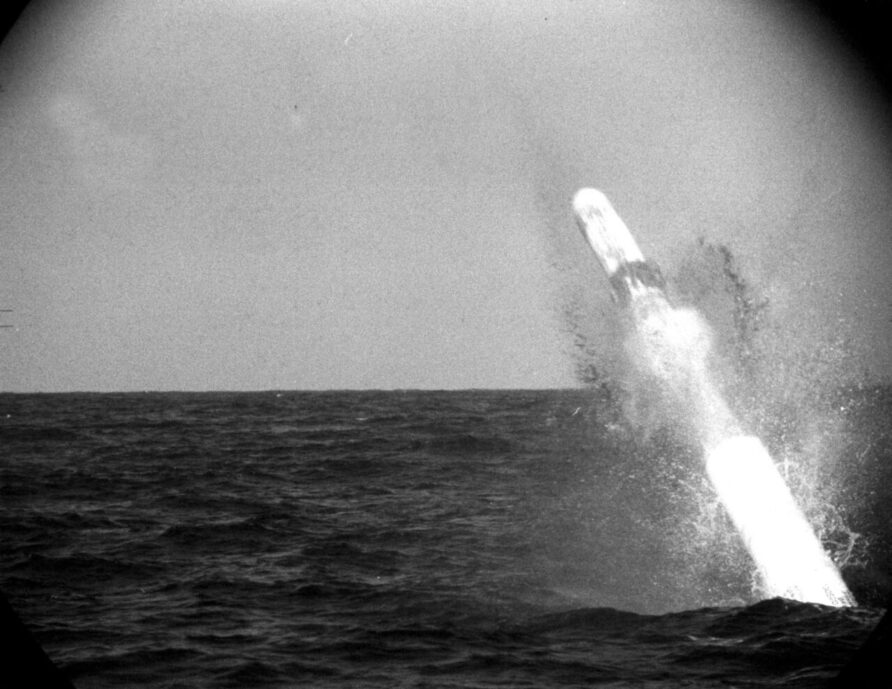
Sub Harpoon was first officially deployed on HMS Courageous at the end of the Falklands Conflict in 1982.
Furthermore, a short time after the conflict, some RAF Nimrod MR.2 aircraft were fitted with air-launched Harpoon missiles.
In 1983, McDonnell Douglas offered the 120 nm range RGM-84 Harpoon Block 1C for use on the Royal Navy’s Type 22 and Type 23 frigates. Block 1C offered various improvements including increased range (80 nm), waypoint navigation and lower altitude flight. The surface-launched storage and launching canister was originally developed for hydrofoil deployment.
In competition with Harpoon was a surface-launched variant of Sea Eagle, the P5T. Sea Eagle was by then entering service with the RAF and Fleet Air Arm. The launch canister for Sea Eagle SL was adapted from a lightweight Sea Dart canister.
Whichever missile won, it was intended to equip the first Type 22 Batch III Frigates. Exocet was not considered suitable, and neither was Otomat.
Further details on Sub Harpoon were released in a Parliamentary Written Answer in 1984
HC Deb 24 January 1984 vol 52 c461W461W
Mr. Dalyell asked the Secretary of State for Defence what was the cost of the acceleration of the Sub-Harpoon submarine-launched anti-ship missile into service, and what is the total cost of the Sub-Harpoon missile.
Mr. Lee Sub-Harpoon entered service with the Royal Navy on schedule in early 1982. However, to meet the requirements of the Falklands emergency later that year, a number of submarines were provided with a capability to fire the missile in advance of the dates that had been otherwise planned. Approximately £600,000 was spent to achieve this.
The total estimated cost of the Royal Navy Sub-Harpoon programme is £450 million
In 1984, Harpoon Block 1C won and a contract for £200 million was placed with McDonnell Douglas, to be designated GWS.60.
HC Deb 12 April 1984 vol 58 cc527-39527 3.30 pm
The Minister of State for Defence Procurement (Mr. Geoffrey Pattie) With permission, Mr. Speaker, I wish to make a statement about the procurement of the next generation of surface-to-surface and surface-to-air guided weapons for the Royal Navy.
For some months we have been conducting a competition for a second generation surface-to-surface guided weapon for the four batch III type 22 frigates and the first eight type 23 frigates. The contenders were British Aerospace’s ship-launched Sea Eagle, McDonnell Douglas’s ship-launched Harpoon, Aerospatiale’s Exocet MM40, and versions of Otomat from Oto Melara and Matra. The thorough-going evaluation of these contenders has taken into account performance, cost and timescale considerations, as well as industrial and employment factors.
The competition has been keen and of considerable benefit in assuring value for money. Following the submission of “best and final” offers from the competing contractors the outcome is clear. Having taken all relevant factors into account, the Government have concluded that the best choice on both operational and cost grounds is the McDonnell Douglas Harpoon; a proven system, which has a 100 per cent. success rate in over 200 firings since 1978, and variants of which are already in service with the Royal Navy and RAF.
Subject to agreement with the company on contractual terms and conditions, we will place a fixed price contract worth some £130 million for Harpoon missiles and associated ship systems for the batch III type 22 and the type 23 frigates. The total value of the programme is of the order of £200 million.
Sub Harpoon was withdrawn from Royal Navy service in 2003 with no direct replacement but a surface-launched Harpoon Sustainment Programme was initiated to maintain Harpoon to its OSD.
At the UK/French 2016 Summit, an intent to co-develop a joint concept phase for the Future Cruise/Anti-Ship Weapon (FC/ASW) programme was announced.
Storm Shadow was subject to a Mid-Life Refurbishment (MLR) that will meet the SPEAR Capability 4 requirement, and take it to its planned out of service period of around 2030. It will be replaced with the SPEAR Capability 5 system, nominally the UK/France Future Cruise and Anti-Ship Weapon (FCASW) / Futur Missile Antinavire/Futur Missile de Croisière (FMAN/FMC)).
The MoD provided greater detail the following year;
The Type 26 Frigate will be delivered with cutting edge weapons and sensors that build on the excellent operational record of the Type 23. Investment in the MK 41 launcher enables the Royal Navy the option of investing in a wide range of additional capabilities at short notice and according to the threat. The Type 26 Global Combat Ship will be fitted with the Mk41 Vertical Launch Silo, providing options for development of Type 26 capability throughout its life. Type 26 is planned to be a key component of the RN’s fleet until at least 2060 and it makes sense to build a strike missile launcher into its design that enables a flexible choice of weapons throughout its service life.
The Mk41 Vertical Launch silo provides the flexibility to field a variety of weapons, which may include the next generation of ship-launched strike weapons – including the Future Offensive Surface Weapon and the Next Generation Land Attack Weapon – being developed through the MOD’s current ten-year, £178 billion equipment plan.
The current planning assumption is that Future Cruise /Anti-Ship Weapon will enter service on the T26 Frigate and Typhoon aircraft in 2028 and 2030 respectively
Harpoon originally equipped Type 22 Frigates and now equips Type 23 Frigates.

Some Type 45 Destroyers have also received the launching system from withdrawn Type 22 Frigates.
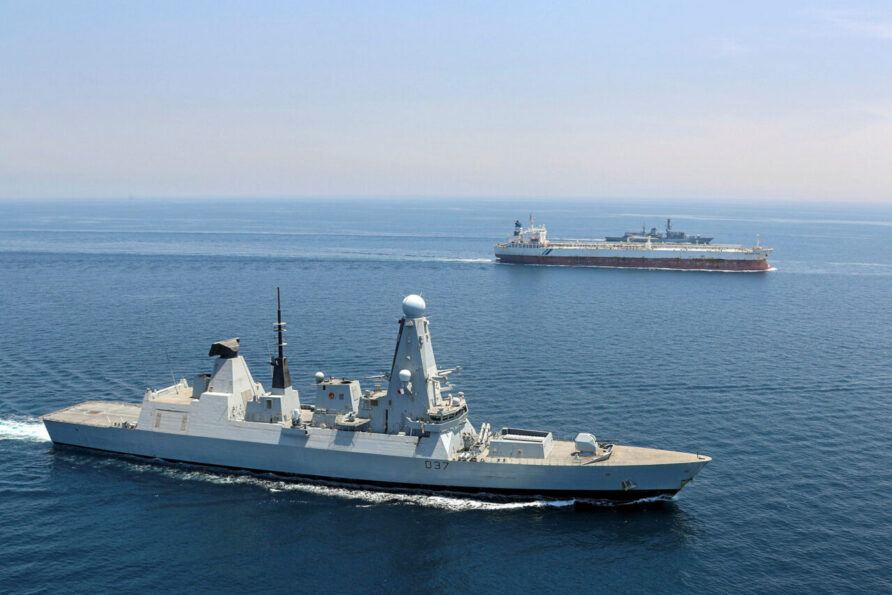
The current Out of Service Date (OSD) for Harpoon was planned to be 2018, the In-Service Support contract with Devonport Royal Dockyard Ltd ran to November 2018.
Like all planned OSD though, this changed with a slight extension to 2023 to retain it in service until the Interim Surface to Surface Guided Weapon System (I-SSGW) enter service.
The Royal Navy continuously reviews the capabilities it requires. While work is in hand to consider options for the replacement of the Harpoon missile system, the Navy has decided to extend its service life beyond 2018.
On the 28th of August 2019, the MoD issued a tender note for the Interim Surface to Surface Guided Weapon System (I-SSGW)
The TTH project team, part of the UK Ministry of Defence, hereafter referred to as the authority, has a requirement for the provision and introduction into service of the I-SSGW system as an interim replacement for the existing system that is going out of service. The I-SSGW is to provide a ship launched over the horizon precision anti-ship capability and a terrain following precision maritime land attack capability. It is anticipated that the I-SSGW capability will operate on X 5 Type 23 (Towed Array) frigates capable of concurrent Anti-submarine warfare (ASW) and Anti Surface Warfare (ASuW) operations in protection of a formed Maritime Tasking Group, for a 10-year period.
The terrain-following requirement likely excluded Harpoon and Exocet.
It was speculated that bidders might include the Lockheed Martin Long Range Anti-Ship Missile (LRASM), Kongsberg Naval Strike Missile (NSM), Saab’s RBS15 Mk4 and the Gabriel V from Thales/IAI called the Sea Serpent.
A March 2021 Written Answer provided an update
The interim surface-to-surface guided weapon will replace the Royal Navy’s existing Harpoon missile capability. There was a healthy response from Industry to the Pre-Qualification Questionnaire and we are planning to proceed to issue an Invitation to negotiate to the down selected bidders later this year.
In February 2022, the MoD confirmed I-SSGW had been cancelled,
The industry was formally notified by the Ministry of Defence (MoD) earlier this month that the Interim Surface-to-Surface Guided Weapon (I-SSGW) programme had been cancelled. This decision came despite a commitment in the March 2021 Defence Command Paper to procure a replacement for the RN’s legacy ship-launched Boeing Harpoon Block 1C missile.
In somewhat of a reversal, a Defence Select Committee evidence session on the 5th July 2022 saw this statement from the Secretary of State for Defence (Ben Wallace MP)
there is an interim plan to replace Harpoon in between what we might settle upon in the long term. I can’t provide details yet as I’m not sure when it will be put out to tender but there is a plan to do so.
At about the same time, a number of defence media sources speculated that the Royal Navy favoured the Kongsberg/Raytheon Naval Strike Missile.
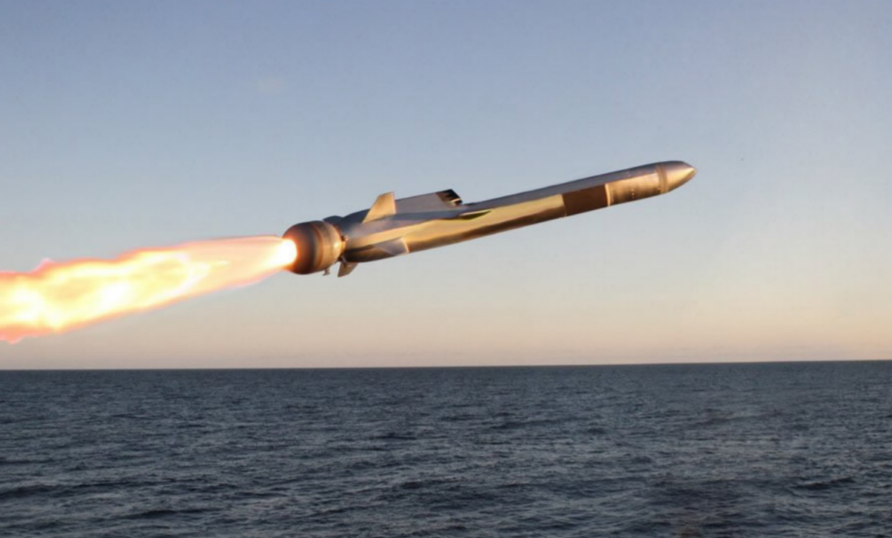
In November 2022, Kongsberg and the MoD confirmed the selection of the Naval Strike Missile
UK and Norwegian authorities have today announced that they have agreed to further strengthen existing defence ties. The Royal Navy will receive the Naval Strike Missile (NSM), outfitted on Type 23 frigates and Type 45 destroyers, in a collaboration with the Norwegian government.
And from the Royal Navy
Eleven Type 23 frigates and Type 45 destroyers will be fitted with the sea-skimming Naval Strike Missile, capable of knocking out major enemy warships at ranges of more than 100 miles away. The MOD today ordered the missile system as the interim replacement for the existing Harpoon, which reaches the end of its active life next year.
The Naval Strike Missile will plug the gap between Harpoon and the advent of its permanent successor, the ‘future offensive surface weapon’, which will become the Fleet’s premier long-range, heavy duty anti-ship missile in 2028, carried by the Royal Navy’s next-generation Type 26 frigates, currently under construction on the Clyde.
UK defence firms Babcock and BAE Systems will install NSM on the 11 warships, with the first ship due to be operational by the end of next year.
Before reading on, would you mind if I brought this to your attention?
Think Defence is a hobby, a serious hobby, but a hobby nonetheless.
I want to avoid charging for content, but hosting fees, software subscriptions and other services add up, so to help me keep the show on the road, I ask that you support the site in any way you can. It is hugely appreciated.
Advertising
You might see Google adverts depending on where you are on the site, please click one if it interests you. I know they can be annoying, but they are the one thing that returns the most.
Make a Donation
Donations can be made at a third-party site called Ko_fi.

Think Defence Merch
Everything from a Brimstone sticker to a Bailey Bridge duvet cover, pop over to the Think Defence Merchandise Store at Red Bubble.
Some might be marked as ‘mature content’ because it is a firearm!
Affiliate Links
Amazon and the occasional product link might appear in the content, you know the drill, I get a small cut if you go on to make a purchase
Harpoon Capabilities
After being launched through a torpedo tube, the sub-harpoon capsule is activated by the snapping of a safety lanyard. Fins deploy to ensure the capsule assumes a vertical position, and it then rises to the surface when the nose and tail caps blow off.
The rocket booster ignites and the missile is propelled to a suitable altitude when the main propulsion motor fires.
For the surface-launched variant, currently, in service, the missile is fired from an angled tube launcher with frangible front and base caps.
The tubes are arranged in groups of four, with two groups arranged to fire port and starboard.
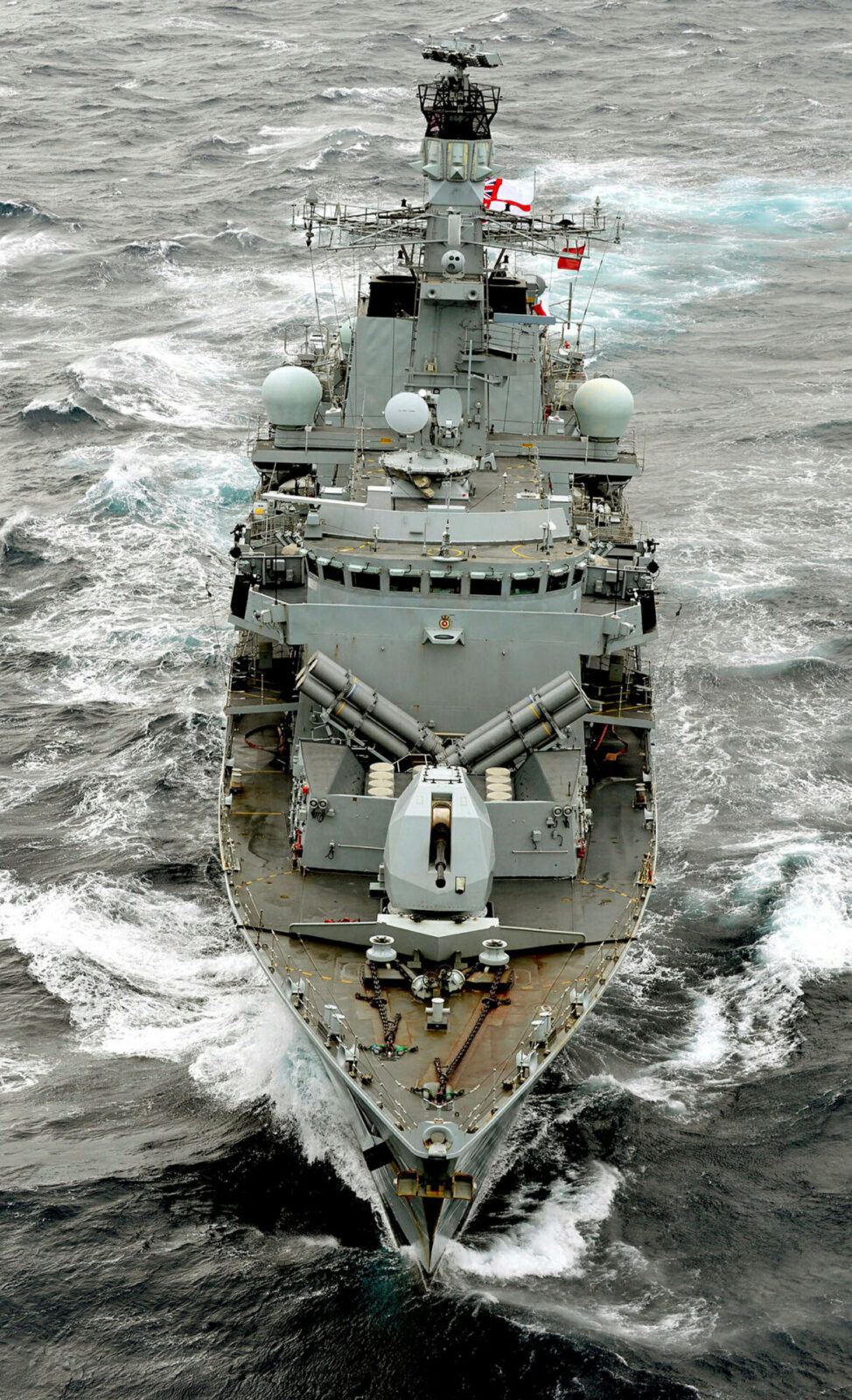
The missile is 4.6m long and weighs 691 kg (with booster). The warhead weighs 221 kg, approximately the same as a Paveway IV, or half the weight of the Storm Shadow warhead.
The maximum speed is 885kph.
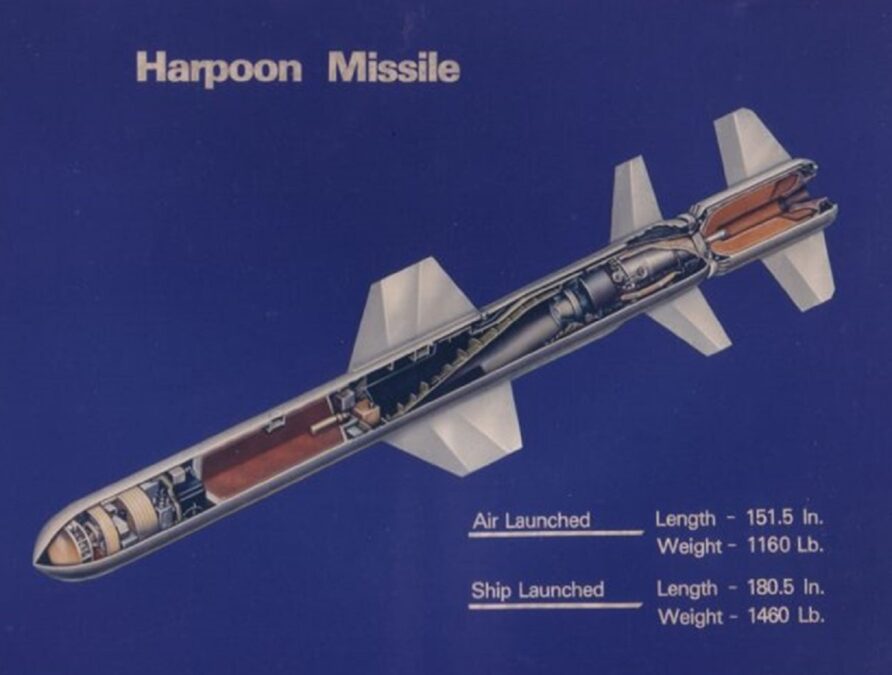
Guidance for Harpoon is performed initially by information provided by the launch platform, waypoints and mid-course changes can also be programmed into the inertial guidance system. Terminal guidance is carried out using the integral radar seeker. The attack profile is also selectable at launch.
The website Missile Threat describes the Block 1C variant in service with the Royal Navy as;
Block IC (RGM/UGM-84D)
Introduced in 1985, the Blk IC differs from previous iterations in its flight path, guidance, and targeting technology.
Whereas Blk IB and IA could perform either a low apogee pop-up trajectory or a sea-skimming approach in its terminal phase, the Blk IC can perform both. In addition to improved ECCM performance, Blk IC has a relatively higher altitude in the first part of its flight path to avoid friendly ships and other land masses that may be in the missile’s path. A change in the type of fuel used in the missile increased its range to 124 km.10
Because of the lack of a data link and the radar terminal guidance feature, Royal Navy Harpoons are often considered to be obsolete in a contemporary operating environment. Future developments, not currently in service with the Royal Navy, are planned to incorporate improved target discrimination and data links to enable its deployment in complex environments with civilian and military vessels in the same area.
Click HERE to read about other UK Complex Weapons
Change Status
| Change Date | Change Record |
| 15/05/2016 | Initial issue |
| 28/07/2021 | Update and format refresh |
| 09/11/2022 | Image refresh and minor additions including additional Parliamentary Answer, a general update on an interim replacement |
| 25/11/2022 | NSM contract award |

